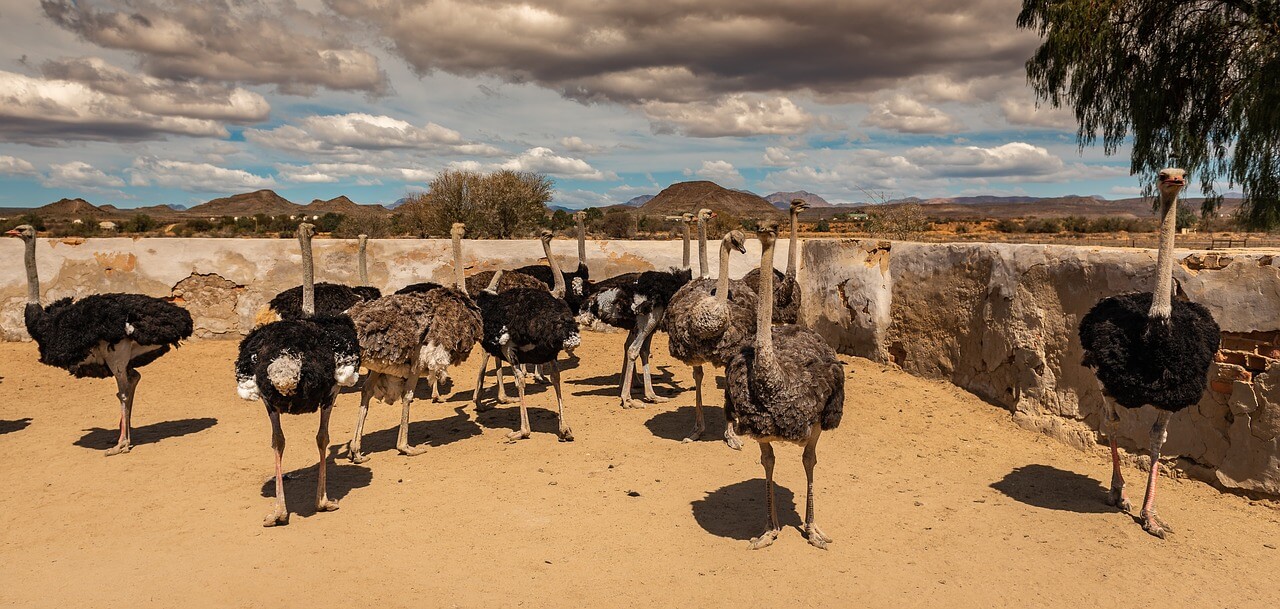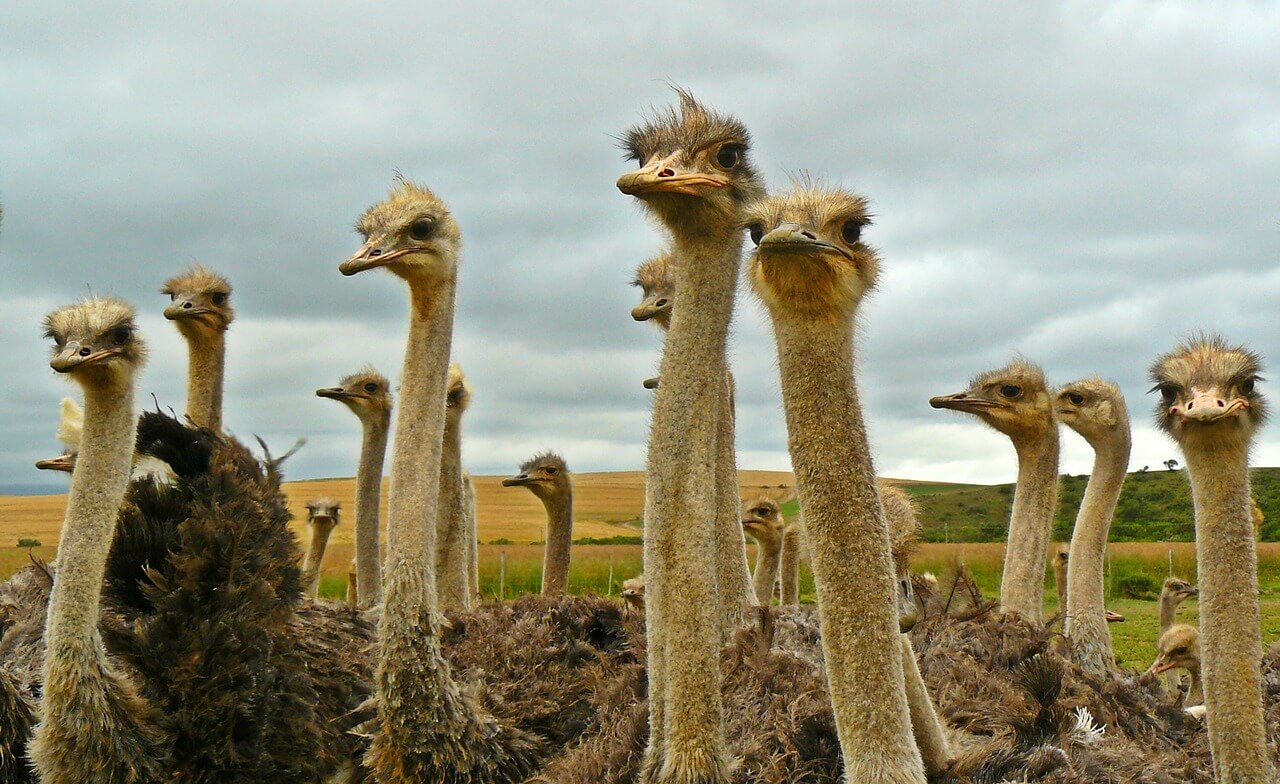Ostriches are not only the largest birds in Africa, they are also the largest birds in the world. An adult ostrich can weigh as much as 350 pounds and can stand 9 feet tall.
Ostriches belong to the bird family known as ratite. Other members of this family include these flightless birds:
- Cassowary
- Rhea
- Kiwi
- Emu
In this article, we discuss raising and caring for an ostrich. Read on to learn more how to raise ostriches.
What You'll Learn Today
How Do You Take Care Of An Ostrich?

Ostrich care is quite different from the care of common domestic poultry such as chickens, turkeys, ducks and geese. Because ostrich farming is a fairly new endeavor, the ways of feeding and raising them are somewhat controversial.
Additionally, the way in which you care for an ostrich will vary depending upon where you live.
The age or phase of life of the ostriches in question also affects the care you provide. As an ostrich farmer, you will be called upon to care for ostriches from egg to old age, and it is important to understand the differences in each phase of an ostrich’s life.
Egg Care
If you are starting with eggs, you will need to keep them at the tree 55 and 65°F. Eggs must also be kept at 70% humidity. Keep them in these conditions for as long as 7 days before you begin incubation.
During storage time and also during incubation, you must turn ostrich eggs once a day.
When you begin the incubation process, you must be certain that the conditions you provide are consistent and remain so for the next 42 days. During incubation, you must maintain humidity levels 25%.
When you transition the eggs from storage to incubation, you must gradually increase the temperature from approximately 60° to approximately 98°F.
Ostrich Chick Care
When the chicks hatch, you must keep them at a consistent temperature of 95°F. After a few days, you may be able to drop this temperature to 80°F.
Be careful using a brooder lamp. If it is too hot, the chicks will stay away from it. If it is not warm enough, your ostrich chicks will pile up on top of each other to stay warm and some may die.
When incubating and brooding chicks, you should have at least 40 feet square of space per chick. You must also be careful to keep your chicks separate from your adult ostriches because ostriches that are around chicks may stop laying eggs.
Ostrich Chicks Need Safe Flooring
For chicks, old carpeting can make good flooring. Be sure to throw out the old carpeting as it becomes soiled. Turn the carpeting upside down so that the smooth side is up.
When using old carpeting as flooring for ostrich chicks, be sure to flame the edges so that there are not any loose threads that your ostriches may become tangled in or that they may eat.
The Bigger The Bird, The More Space Is Needed
When housing yearlings ostriches, keep in mind that they need more space to roam. Generally speaking, you can keep between 6 and 10 yearling ostriches in a pen that is 100 feet by 300 feet.
It’s a good idea to put double fencing around the pen to prevent escapes. Additionally, you should have a very secure gate because ostriches are escape artists.
How Much Land Is Needed To Raise Ostriches?
You must always be sure to provide ostriches with plenty of space. You need a minimum of 43560 square feet (one acre) for each mature ostrich. If ostriches are cramped, they will not breed.
Overcrowding of birds can cause feather picking just as it can with chickens. Ostriches need plenty of room to move about and feel comfortable.
You’ll also need a smaller pen, approximately 40′ x 8′ to use as a catch pen. The purpose of this sort of pen is to work with your adult birds for purposes such as grooming, veterinary care, vaccinations and the like.
Avoid placing your ostrich pens in areas where over head power lines cross. This can tend to make ostriches be uncomfortable and may lead to infertility.
Ostrich Fencing Must be Strong
When building fences for ostriches, remember that they can grow to be 9 feet tall. The minimum height for enclosing adult ostriches is 6 feet.
You need strong fencing for ostriches, and chain-link fencing is best. You can use a welded wire fence with openings no larger than 2 inches by 4 inches.
Alternately, you could use horse panels that have openings that are not large enough for ostriches to stick their heads through. You should never use non-welded wire because ostriches can push on it, stretch it and break it.
To prevent ostriches digging holes under the fence, you should start your pen by digging the whole thing down about 6 inches and laying fencing down.
Cover it with a minimum of 6 inches of soil to prevent ostriches from digging holes. Having the entire undergirding of the pen reinforced with fencing will also prevent predators from digging their weight in.
Ostriches Are Desert Animals
If you live in a cold area, you’ll need to work to keep your ostriches warm enough at any age. These curious birds will tend to peck at anything unusual, so an electric heater can lead to electrocution.
Likewise, any exposed electrical cords will cause problems, and even light bulbs may be pecked and end up electrocuting your ostriches.
In very cold climates, you may need to invest in heated waterers for your ostriches so that they always have drinkable water even in below zero temperatures.
Shelter Is Essential
Your ostriches will also need a shelter. East each ostrich needs a 12 foot by 12 foot shelter with the door that is 6 feet wide and 8 feet high.
It’s best if doors are offset to one side of the shelter provide maximum protection against winds. In a mild climate, you may be all right with a three sided shed. Just be sure that your birds can get entirely out of the wind and rain.
In hot climates, you must be sure that your birds have the ability to get out of the sun. You might think it’s a good idea to install sprinklers to help your birds steak, this can cause fertility in some in.
Safe Housing For Ostriches Can Be A Challenge
Ostriches are accident-prone. When designing their living space and purchasing equipment such as feeders and waters always be on the lookout for ways that they could hurt themselves.
Examples of ways that ostriches hurt themselves include:
- They get their heads caught in narrow spaces.
- They eat loose screws.
- They pick things apart.
- They eat paint chips.
If you have ostriches in a large pasture where weeds and native plants may present, you should have your veterinarian come out and walk the property for plants that may be poisonous your ostriches.
Locate A Good Ratite Vet Before Acquiring Ostriches

You’ll need to have a good relationship with a veterinarian who specializes in ratite care. Your vet can help you take good care of your ostriches every step of the way, from banding male and female chicks for identification to care of injuries, nutrition advice and much more.
When you tag your young ostriches, it’s also a good idea to have your veterinarian install a microchip on the left side of your birds neck. In this way, if your ostrich escapes, it can be identified as yours even if it loses its leg band.
Your veterinarian will also need to provide you with health certificates for each animal. This is especially important if you need to transport your birds from one state to another. You must have proper veterinary paperwork on hand during transport.
You should always call your veterinarian right away if your ostriches show any signs of illness such as:
- Unexplained weight loss
- General listlessness
- Trouble breathing
- Fluffed feathers
- Nasal discharge
- Swollen joints
- Feather loss
- Droopy eyes
- Diarrhea
Generally speaking, ostriches do not require vaccinations; however, diseases such as bird pox or E. coli diarrhea can necessitate some vaccinations.
Why Raise Ostriches?
Although it takes quite a bit of setup to prepare for raising ostriches correctly, once you have everything in place, you can expect to make a good return on your investment.
Additionally, when you choose to raise ostriches, rather than animals such as cattle or pigs, your choice has a positive impact on the environment and on the health of the general population as more and more people learn the value of substituting lean, healthy, hormone free ostrich meat for beef, pork and other types of meat that are currently produced on cruel and unsustainable factory “farms”.
It seems like raising ostriches not that easy? Do you think it would be cheaper to raise chickens or ducks instead?
i just bought 2 black ostrich chicks unsexed
not sure if i have male and female please help how to identify them
i will be raising them in 10 Morgan farm with cows goats and sheep is it advisable
currently keeping them in my yard fenced where there is flowers and vegetable garden and not sure if flowers can be harmful
I want to raise ostriches, what is the minimum amount of space needed for such a venture?